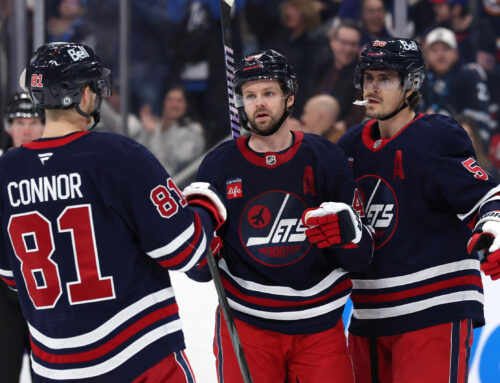
Taking a close look at the power-play potential of some Western Conference teams…
Power play statistics make up some key categories in many of our pools and anticipating these numbers year after year can be a difficult process. We know that the top 30 scorers in the league will get their share of power play points and the elite players will always contribute. One obvious strategy is taking first line players who get ample power play time or blue liners who quarterback the first power play unit. In fact, this is so obvious it brought great pain even writing it. In saying that, year after year there are fluctuations, even among the most reliable producing players and teams.
Looking at individual players and analyzing their power play statistics is worthwhile if you want to win your pool. So for this week's edition of The Wild West, we will look at some individual power play numbers and also take a deeper look at how teams in the Western Conference fared last year with the man advantage.
Final Thoughts
As mentioned at the beginning of this article, anticipating power play points out West is no easy task. The Anaheim Ducks and Los Angeles Kings are current samples of teams who were great last year despite lackluster power plays. In 2013-14 the Kings were 25th overall and the Ducks were 27th overall when looking at power play goals per 60 minutes. An interesting twist here is that during the lockout shortened 2012-13 campaign, the Ducks and Kings were actually quite good. Anahiem was third overall (8.02 PPG/60 minutes) and Los Angeles was sixth overall (7.39 PPG/60 minutes) as both teams experienced tremendous power play success.
As for total power play goals, in 2013-14 the Kings finished 22nd and the Ducks finished 24th. In 2012-13 the Kings finished 7th and the Ducks finished 11th as both teams racked up the goals after the lockout. Again, anticipating power play success is tough, as both teams could easily reverse the trend again and return to the top 10 in 2014-15, showing us how power play trends are difficult to analyze.
Finally, the Phoenix (now Arizona) Coyotes are a true example of how the power play pendulum can swing in the Western Conference. In 2012-13 the Coyotes were dead last in the league with just 4.32 power-play goals per 60 minutes and were second worst in the West after the lockout, scoring just 19 power play goals. Fast forward to 2013-14 where the Coyotes led the West in both of these categories.
Bonus Facts – Both Conferences
Nashville was the only team in the league not to allow a short-handed goal in 2013-14, another example of Weber's and Josi's dominance.
Los Angeles had the second most TOI in the league in 2013-14. Meanwhile, Florida had the third most PP TOI, so perhaps there is some hope the Kings and Panthers can produce after all. Both teams are clearly getting opportunities and just need to cash in. With an improved roster perhaps some Panthers make for some nice under the radar PP contributors this year. Going back to 2012-13, the Panthers finished 8th overall with 6.9 PPG per 60 minutes.
Montreal had the fourth most PP TOI last year but finished in the bottom half of the league in both total PP goals and PPG per 60 minutes.
Philadelphia finished in the top five in all three categories in 2013-14. They were fifth in PP TOI; third in PP goals; and fifth in PPG per 60 minutes. Look to the Flyers if you need some PPP in 2014-15.
Four teams missed the playoffs despite being in the top 10 in power-play goals scored – Washington, Philadelphia, Toronto and Ottawa. Those same four teams also finished in the top 10 in PPG per 60 minutes along with Nashville, another team that missed the playoffs despite a solid power play. One that is likely to improve with Ribiero and Neal, cue that 60 point season for Shea Weber?
Under Ralph Krueger, the Edmonton Oilers score 7 PPG per 60 minutes in 2012-13. Last year this number dropped to 5.73 goals per 60 minutes.
Washington has been the most dominant power play team over the past two years. As mentioned above, the Capitals led the league in total power play goals last year and most PPG per 60 minutes. In 2012-13 they also led in total goals with the man advantage and produced 10.04 power play goals per 60 minutes. A Trotz coached team with an already dominant power play could mean the Caps are for real. Perhaps Niskanen won't regress despite the change of scenery and Green could be good for 50 points if healthy.
**********************************************************************
In closing, I want to give a shout out to forum member glorybe23 for what amounted to be two very interesting and entertaining threads this summer. If you have yet to come across his great work I would suggest checking these threads out. This guy has a real talent for creating team logos, and a number of Dobberhockey members were lucky enough to benefit from his genius and generosity. Thanks again glorybe23 and well done!
** Get the Fantasy Hockey Guide, Prospects Report, Midseason Guide AND Playoff List for only $10!! Details here





 FLA
FLA CHI
CHI NYR
NYR PIT
PIT L.A
L.A COL
COL CAR
CAR OTT
OTT TOR
TOR T.B
T.B
 MIN
MIN NYI
NYI BOS
BOS WSH
WSH
